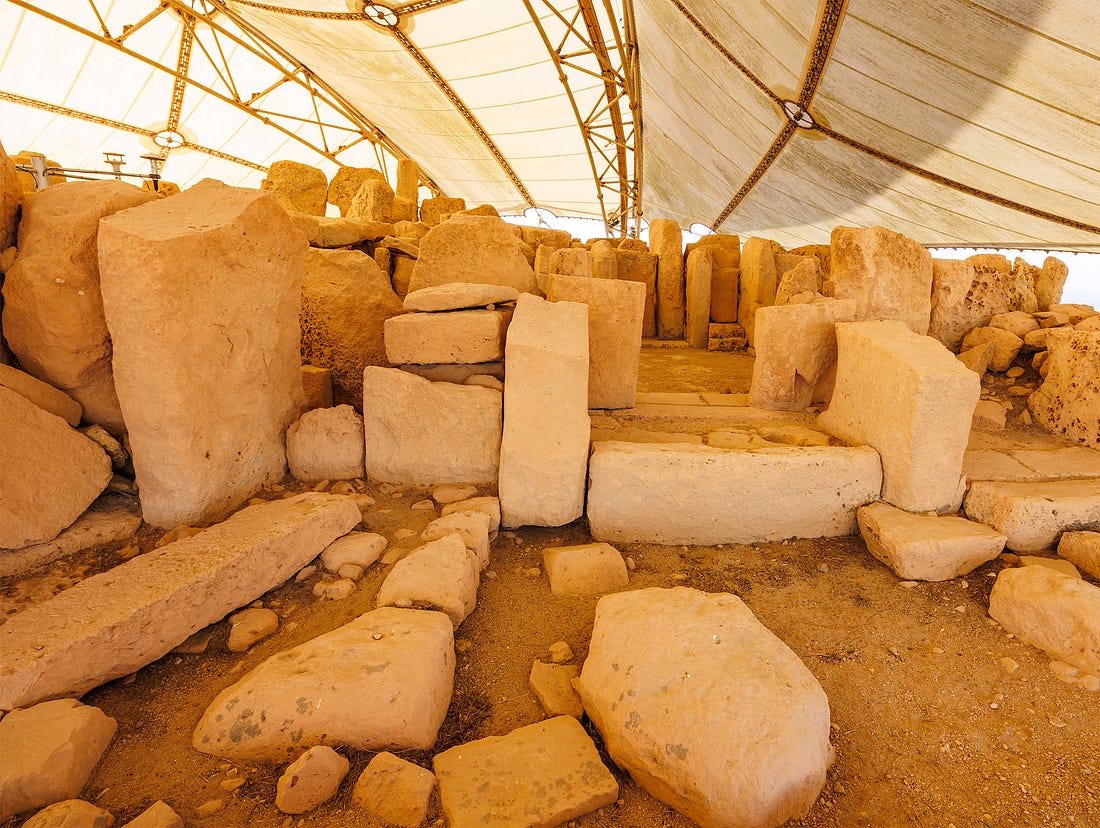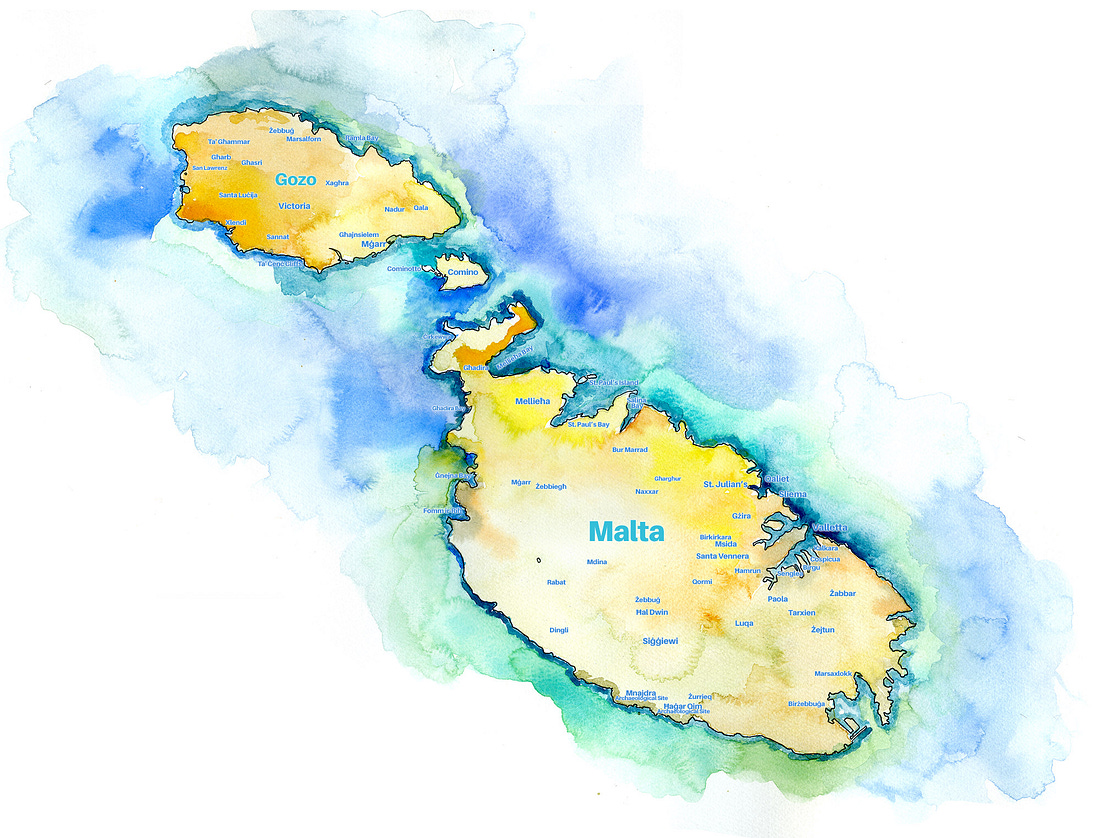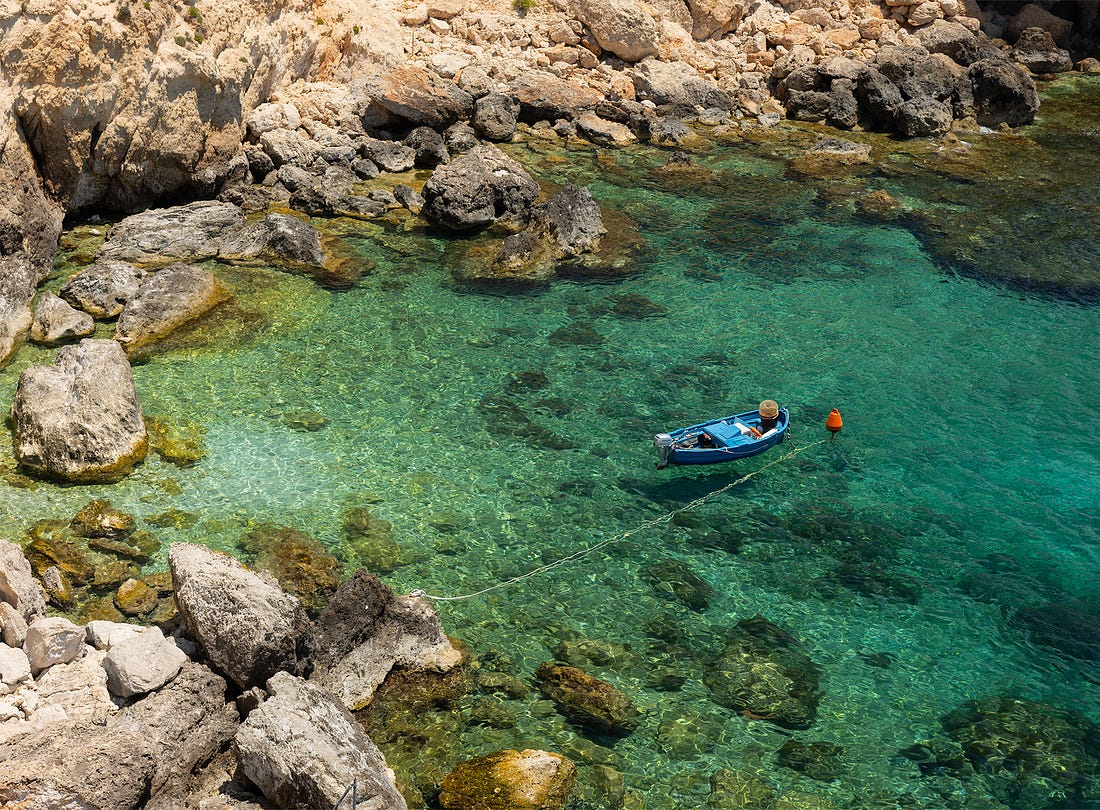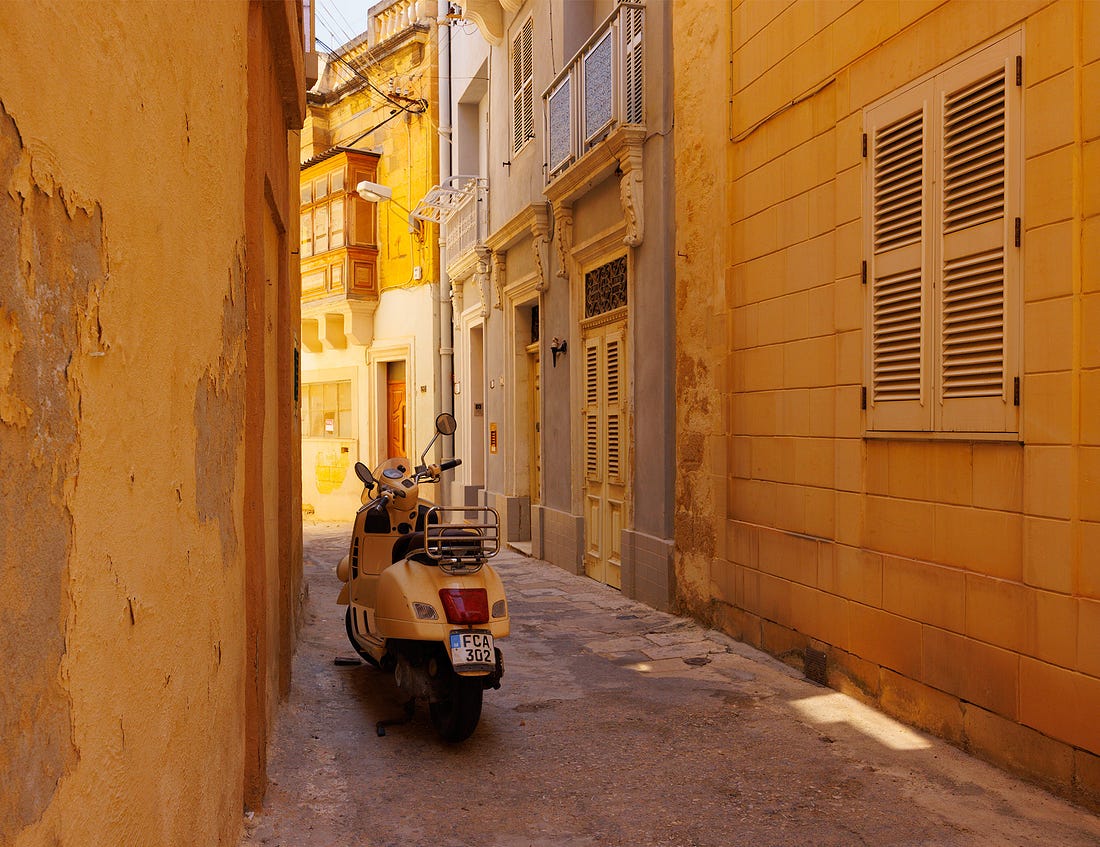Following the Ġbejna Trail Across MaltaFrom Neolithic seafarers to modern refugees, the hidden history of Malta is written in cheese.This is the first of a 3 part series. These notes can be found with higher resolution images at Notes from the Road. The sun has not yet risen over Malta. I am explaining to Mebratu, my rideshare driver, about my interest in Malta’s signature cheese, Ġbejna. And that this interest began when, twenty years ago, I invented a sort of muse—a fictional traveler who retired from his career as a maître d' fromage to travel the world in search of its most special cheeses. “But why make him up?” he says in his Eritrean accent, “when there are so many good real ones, like Bourdain, or that bald guy that eats disgusting food?” I told him that those people are presenters whose tickets are booked and itineraries planned by someone else. I guess I wanted a muse who was an independent traveler and could see the world through his own experience. I wanted someone who thought that cheese could explain everything about the world because that had been his career and it was his perspective. No one was paying for him to have a presentable perspective. We take a turn on a bend on the windy road to the southwest coast, when, unimpeded by limestone rock walls or stands of prickly pear and yucca, we see the early morning light floating across the Mediterranean Sea. “If I see the ocean every day,” Mebratu says, “I am good.” He wags his finger triumphantly. “And I love this view more than any other.” Mebratu moved to Malta 18 years ago. “I wanted two kids,” he says, “but my wife give me three. So is the way life goes.” And he laughs and explains how grateful he is to be able to live here. “There is peace, and that is all that matters.” I tell Mebratu how I’d been reading book after book about the savage wars that played out here in Malta. How it seemed like the island nation had been the center of the world’s most brutal battles. But then I started Salt by Mark Kurlansky, and it reminded me that most of the Mediterranean's history is long periods of absolutely nothing. I explain that my brother said something that stayed with me: history isn’t just the big conflicts. It’s mostly long stretches of people farming, tending goats, making food, raising children, just living. The history books tend to skip those parts. But maybe that’s the history that actually matters. “I want to forget conflict, so I can understand seeing it like that,” Mebratu says, “but my history is not just living.” I prod him to tell me his personal history, about how, during the war of Independence against Ethiopia, he was conscripted into the Eritrean People’s Liberation Front at age 10 as a child soldier. “1991,” he explains. “The horror!” He thinks before continuing, “Then war breaks out again when I am 18. I knew then I had to go. It was horror. All horror.” He fled toward the deserts of Sudan, but lived in a refugee camp there for a year. From there, he took trucks north, on trips so devoid of water and so ripe with intense heat that many people died en route. He lived in Tripoli “for a couple years” and eventually found passage on a rubber boat. He is still telling his story when we arrive at the entrance of the Ħaġar Qim archeological site. “What will this place tell you about cheese?” Mebratu says. I tell him, “Nothing. I just want to see it before my wife and son wake up.” But that was more out of respect for the gravity of his story, and it wasn’t quite true. Ħaġar QimI am sitting outside the visitor center of the archeological park that shares access to the twin neolithic temples of Ħaġar Qim and Mnajdra. They are both UNESCO World Heritage sites. Even this early in the morning, the heat swelters. This climate-change fueled Mediterranean heatwave is now confirmed as the hottest June the region has ever recorded. In nearby Greece and Turkey, thousands are evacuating as temperatures reach the triple digits. Yesterday, I read a news report about temperatures reaching almost 123 degrees fahrenheit in Silopi, Turkey. Here in Malta, temperatures had hit 106 degrees only a few days ago. Today, while those temperatures had cooled to 92 degrees, Malta has been facing unusually high humidity levels. There is none of that expected Mediterranean wind, and the humidity levels are peaking at nearly 70%. I know why I am here early in the morning, and I also know that the walk from the Ħaġar Qim neolithic site to the Mnajdra site is only a third of a mile. But I also know that in this heat, the walk there and back shouldn’t be trifled with. I walk out to Ħaġar Qim, which is protected from the sun and wind by a giant sail-like dome. This massive prehistoric temple complex sits above cliffs and looks out over blue ocean and the uninhabited Filfla islet. It was built over 5,000 years ago from the same honey-colored limestone that permeates almost every home and building in the Maltese islands. But these are limestone slabs which weigh several tons. They are arranged in curved, cloverleaf-shaped rooms complete with doorways and altars. The walls are weathered, but mostly still standing, and the stones fit together without mortar. The existence of carved limestone statues depicting obese crouching females suggests the temple was used to worship fertility, or possibly nature. It doesn’t take much to imagine how the temple site looked when it was built. Even if was built today, we would see it as a masterpiece, an impossibly beautiful space. Archaeologists believe these temples were constructed using only stone, rope, levers, wooden rollers, and muscle. They had no metal tools or wheels. Ħaġar Qim, one of the oldest free-standing structures on Earth and its existence reiterates that Malta had an organized and successful civilization 5,000 years ago. I am the first visitor to this temple today, and in the quiet, I try to picture the ancient Maltese, building these temples, out here in a place that feels like the end of the world. So who were they, and how did they make it to Malta so long ago? Seafarers actually existed in the Mediterranean as far back as the Paleolithic age. Archeologists have evidence of seafarers using dugout canoes or skin-boats that were capable of open water navigation as far back as 12,000 years. By the time people first arrived in Malta, the Mediterranean would have already had a 4,000-year-old history of open water maritime history. The Neolithic Maltese crossed the 56-mile stretch of Mediterranean from Sicily around 5900 BC, about 8,000 years ago. They definitely had a reason to leave. While Malta was uninhabited, Sicily had already seen thousands of years of human presence. Some archaeologists believe it was settled as early as 24,000 years ago. In the many millennia that followed Sicily’s inhabitation, the early Sicilian farmers gradually overused their land. Around 6000 BC, the island’s soil begins to tell that story: forest pollen vanishes from sediment layers, replaced by traces of weeds, cereal crops, and ash. People began clearing their hillsides with fire. Their goats, brought over from mainland Italy, grazed so heavily that the forests couldn’t recover. At first, the soil was fertile and growing grains was easy, but with the slopes stripped bare, the rain began to wash the soil away. Erosion followed, and with it, the slow collapse of biodiversity: fewer wild plants to forage, fewer animals to hunt. By the time of the crossing, sheep and goats had been grazing across Sicily for generations. These domesticated animals, introduced long after the Paleolithic, were now accelerating the land’s decline. The goats were chomping at the hillsides, desertifying the land. For the neolithic people struggling on broken land in Sicily, Malta was a new opportunity to start fresh. When the first Neolithic settlers crossed from Sicily to Malta, they brought with them everything they needed to build a new life from scratch. They stuffed their canoes with sacks of wheat and barley, lentils and flax seeds. They brought stone axes, blades, and grinding rocks for clearing land and processing grain. They brought clay pots, wooden bowls, and bone needles, fire-starting kits made of flint and pyrite. They wore hides or simple flax clothes, and carried baskets and ropes. From Sicily, they had everything they needed to replicate an organized society in their almost identical, but untouched new environment. Among their cargo was sheep and goats. These animals meant meat, wool, and milk, which allowed them to produce one of the earliest forms of cheese. Archaeologists have found pottery at Neolithic Maltese which contained fatty acid residues consistent with milk processing, and clay fragments that resemble early cheese-strainers have been unearthed throughout the Mediterranean, including nearby Sicily. The first Maltese cheese was almost certainly simple, soft, probably moister and softer than Middle Eastern Labneh, and almost like a yogurt. If it tasted similar to modern cheese, it would be the yogurt-like Jben that was the first cheese I ever wrote about. This first cheese of Malta was almost certainly made using rennet from the stomachs of young goats or sheep. That rennet is an enzyme that curdles milk by separating it into solid curds and liquid whey. They probably used woven baskets to drain the curds, forming soft, fresh cheese similar to yogurt or feta. Without refrigeration, some of it would have been dried in the sun to preserve it for later use. MnajdraI begin the short, but intensely hot walk from Ħaġar Qim to Mnajdra with my ice-cold water, thinking about Mebratu’s trek across sunbaked Sudan and Libya. Could he even survive the same trip today, in 2025, versus back then in 1998? Summer heat levels of 122 Fahrenheit, common today, would have been unheard of in 1991, and heatwaves in the African Sahel have doubled. But the water sources are drying up too. With fewer water stops, the hazards of migration are increasing. Today, we can see floods, wildfires, and hurricanes growing more severe, and it’s easy to deduce that climate change is making them worse. But these are survivable events: floods recede, hurricanes can be evacuated, fires outrun. Cities rebuild. The news often treats them as the worst consequences of climate change. They’re not. The real danger lies in the collapse of biodiversity, the drying of freshwater sources, and the unraveling of agriculture. Human civilization will likely fall before the most extreme ecological thresholds are crossed, because it takes far less to unseat humanity, driving it to abandon its institutions of education, Democracy and science, causing it to collapse into chaos and conflict. Just look at how quickly the pandemic brought the world to a halt. In North Africa and the Middle East, this unraveling has already began. Climate change has become a dry worldthreat multiplier, accelerating conflict, creating new cracks of instability. In Syria, a devastating drought that lasted between 2006 and 2010 displaced a million people, fueling unrest that tipped the nation into civil war. In Yemen, the water tables have collapsed after decades of overuse, and climate-driven drought has deepened an already catastrophic conflict. Libya’s freshwater infrastructure has crumbled alongside the nation’s political chaos. In both Iraq and Iran, sandstorms, water shortages, and agricultural collapse are bringing chaos to the countryside. Egypt is seeing rising tensions with Ethiopia over control of the Nile, as climate change alters rainfall patterns near the river’s source. In the Sahel and southern Sudan, worsening droughts and desertification have intensified ethnic violence and driven mass displacement. Democracy vanishes quickly with drought and heat. Rising heat, vanishing water, and parched farmland push already-fragile societies toward the brink. The same anti-immigration sentiment that simmers across the Mediterranean today exists equally in Malta too. But what about a hundred years ago? St. Deuberex Montclair, my fictional cheese traveler, would have witnessed it firsthand as he rode the rails through Europe in the years before and between the World Wars. From his seat in a train, looking out across endless Mediterranean towns, he would have seen a continent gripped by rising nationalism and a growing disdain for outsiders. If you wanted to blame your hardships on someone else, there was an anti-immigrant rhetoric out there to intoxicate you. Montclair might have spoken up when he overheard slurs aimed at Eastern Europeans, Jews, or the Roma—communities he knew well. He was part French, part British, and part Roma himself, and as a Maitre’d fromager, he would have collaborated with immigrants at every level of the food world. He understood that immigration came with both costs and benefits, and he believed nations had the right to shape their policies by balancing their national interests and values. But what he saw in those years wasn’t debate over costs and benefits at all, it was blind fervor, weaponized by something truly sinister; and an innate switch that can be easily turned on among our dimmest bulbs. And he could sense it wouldn’t end well for Europe, not once, but twice. When I find relief under Mnajdra’s protective canopy, I try to make sense of this structure, and how it’s different from Ħaġar Qim. In fact, Mnajdra gives a very big hint about the true purpose of these temples. Here, the rising sun shines directly through the main doorway during the spring and autumn equinoxes, illuminating the central axis of the temple. On the summer solstice, the sunlight hits a decorated slab on one side of the doorway, and on the winter solstice, it hits a similar slab on the opposite side. This precise astronomical alignment shows that Mnajdra was a giant solar calendar, a tool to help its Neolithic farmer-builders track the agricultural seasons. The cheese those first migrants made, the first Maltese cheese, is lost to time. But if I follow the imaginary trail left by St. Deuberex Montclair, I’ll find that Malta’s most beloved cheese, Ġbejna, isn’t a relic of a single moment. It’s a living artifact, shaped by thousands of years by successive waves of immigrants, each one bringing their own herds, their own methods, their own hopes. In Ġbejna, we can understand Malta not by its horrific conflicts, but by the thousands of years in between. This is the first of a three part series. Part II will be published in two weeks. Notes from the Road is free today. But if you enjoyed this post, you can tell Notes from the Road that their writing is valuable by pledging a future subscription. You won't be charged unless they enable payments. |




